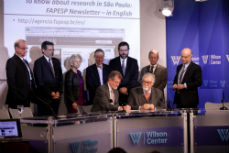News
FAPESP and the Smithsonian Institution sign cooperation agreement Versão em português
 The institutions will support joint projects that bring together researchers from the state of São Paulo and the world’s largest museum complex (photo: Michael Darden / Brazil Institute, Wilson Center)
The institutions will support joint projects that bring together researchers from the state of São Paulo and the world’s largest museum complex (photo: Michael Darden / Brazil Institute, Wilson Center)
Directors of FAPESP and the Smithsonian Institution signed a research cooperation agreement October 28, 2014, in Washington, DC.
FAPESP President, Celso Lafer, and Smithsonian Institution Interim Under Secretary for Science, W. John Kress, signed the agreement during the symposium FAPESP-U.S. Collaborative Research on the Amazon organized by FAPESP in partnership with the United States Department of Energy (DOE) and the Brazil Institute of the Wilson Center.
Established in 1846 by scientist James Smithson (1765-1829), the Smithsonian Institution is the largest museum complex in the world, with 19 museums and galleries, nine research centers and the National Zoo in Washington, DC.
The agreement between the Smithsonian Institution and FAPESP seeks to implement scientific and technological cooperation between researchers from the Smithsonian and the state of São Paulo through joint research projects, researcher exchanges and the organization of symposiums, workshops and other events.
Calls for proposals will be issued to select projects that bring together researchers from universities and research institutions in the state of São Paulo with researchers associated with the Smithsonian Institution.
The agreement is valid for five years and may be extended.
Learn more at: www.fapesp.br/en/9028
